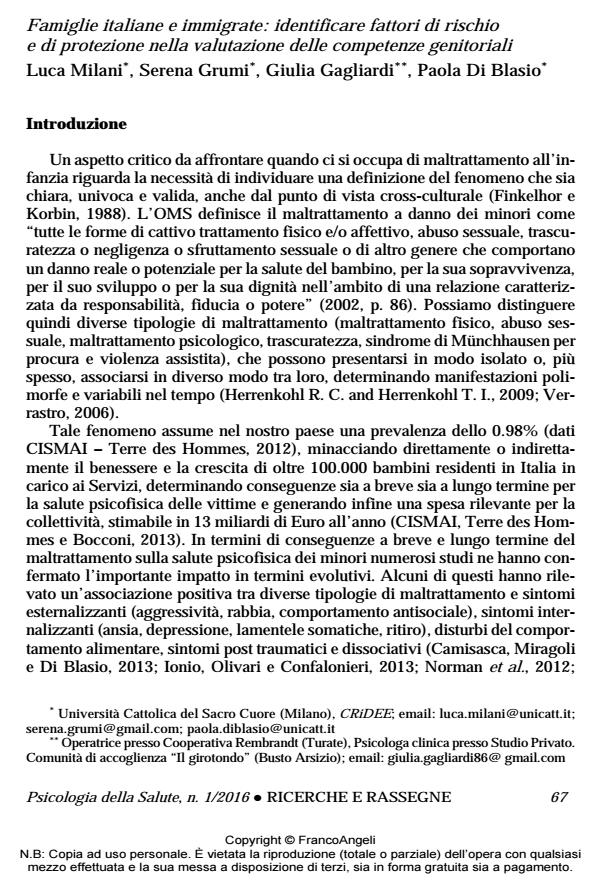Italian and immigrant families: Assessing risk and protective factors in the evaluation of parenting skills
Journal title PSICOLOGIA DELLA SALUTE
Author/s Luca Milani, Serena Grumi, Giulia Gagliardi, Paola Di Blasio
Publishing Year 2016 Issue 2016/1
Language Italian Pages 23 P. 67-89 File size 159 KB
DOI 10.3280/PDS2016-001008
DOI is like a bar code for intellectual property: to have more infomation
click here
Below, you can see the article first page
If you want to buy this article in PDF format, you can do it, following the instructions to buy download credits

FrancoAngeli is member of Publishers International Linking Association, Inc (PILA), a not-for-profit association which run the CrossRef service enabling links to and from online scholarly content.
Child abuse is a major public health issue, which threatens psychological and physical well-being of almost 100.000 minors in Italy. In order to better protect those minors and to favour their positive adaptation, an early assessment of those that are at risk of being maltreated is crucial. The assessment of risk is particularly difficult in migrant families, which are often in a state of vulnerability. The aim of the present study is to: a) evaluate the efficacy of the Risk and Protective factors Protocol (Di Blasio, 2005) in the identification of children at high risk in those families referred to Child Protection Services and b) to highlight specific risk and protective profiles of Italian and foreign families. For this aim, Social records of 58 Italian children and 69 immigrant children were analyzed. Results show that the protocol is useful to discriminate high- and low-risk families regardless of their country of origin. Furthermore, results show that Italian families and foreign families are characterized by different profile of risk and protective factors. Consequences in terms of public health are discussed in the light of the existing literature.
Keywords: Child abuse/maltreatment, immigration, risk factors, protective factors, risk assessment.
- Adattamento di coppia, cogenitorialità e benessere psicologico dei figli: uno studio esplorativo Elena Camisasca, Sarah Miragoli, Luca Milani, Paola Di Blasio, in PSICOLOGIA DELLA SALUTE 2/2016 pp.127
DOI: 10.3280/PDS2016-002007 - Risk and Protective Factors regarding Child Neglect: Differences among Immigrant and Italian Parents Francesca Ranghetti, Luca Milani, in Journal of Aggression, Maltreatment & Trauma /2022 pp.44
DOI: 10.1080/10926771.2021.1970671 - Padri maltrattanti coinvolti nella Tutela Minorile: un focus sui fattori di rischio e di protezione Serena Grumi, Eleonora Mascheroni, in MALTRATTAMENTO E ABUSO ALL'INFANZIA 3/2017 pp.111
DOI: 10.3280/MAL2017-003007 - Children and Peace Luca Milani, Sarah Miragoli, Serena Grumi, Paola Di Blasio, pp.3 (ISBN:978-3-030-22175-1)
- Risk assessment in a multicultural context: Risk and protective factors in the decision to place children in foster care Serena Grumi, Luca Milani, Paola Di Blasio, in Children and Youth Services Review /2017 pp.69
DOI: 10.1016/j.childyouth.2017.04.009 - Empatia e Child Abuse Potential Laura Salvioni, in MALTRATTAMENTO E ABUSO ALL'INFANZIA 1/2020 pp.113
DOI: 10.3280/MAL2020-001008 - Familial risk and protective factors affecting CPS professionals’ child removal decision: A decision tree analysis study Luca Milani, Serena Grumi, Elena Camisasca, Sarah Miragoli, Daniela Traficante, Paola Di Blasio, in Children and Youth Services Review 104687/2020 pp.104687
DOI: 10.1016/j.childyouth.2019.104687 - The CPS Workers’ Child Removal Decision in Cases of Domestic and Witnessed Violence Luca Milani, Serena Grumi, Elena Camisasca, Sarah Miragoli, Martina Cattani, Paola Di Blasio, in Journal of Interpersonal Violence /2023 pp.6819
DOI: 10.1177/08862605221137710 - Supportare la genitorialità in contesto migratorio. Riflessioni a partire da un'esperienza nei servizi Gandolfa Cascio, Mario Limodio, Bernadetta Maini, Federica Massari, Vanessa Oluyemi, Anna Maria Petitti, in PSICOLOGIA DELLA SALUTE 3/2024 pp.62
DOI: 10.3280/PDS2024-003007
Luca Milani, Serena Grumi, Giulia Gagliardi, Paola Di Blasio, Famiglie italiane e immigrate: identificare fattori di rischio e di protezione nella valutazione delle competenze genitoriali in "PSICOLOGIA DELLA SALUTE" 1/2016, pp 67-89, DOI: 10.3280/PDS2016-001008